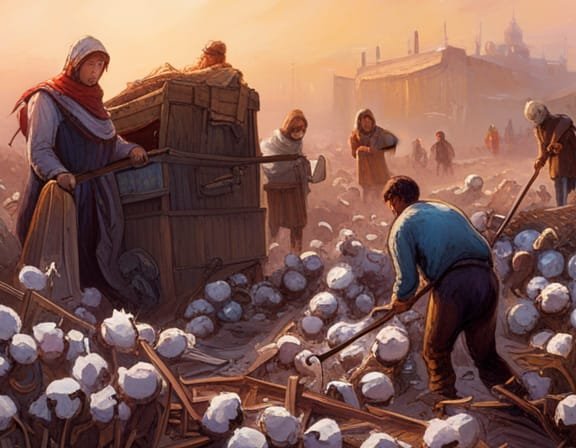Addressing Forced Labor in Trade Using Advanced Technology

A Crucial Step Towards Ethical Supply Chains
International trade of goods presents diverse opportunities, including fostering economic growth and facilitating the exchange of products, ideas, and innovations. Sadly, the prevalence of inhumane labor practices in supply chains detracts from the proven benefits of trade. Thus, countries are beginning to regulate international supply chains to prevent forced labor. These regulations are creating data acquisition and data management problems for importers and customs brokers who are tasked with compliance. Those problems are complex enough to require a technological solution. The legacy method of trade compliance management, email, PDFs, attachments and spreadsheets simply cannot scale to accommodate the demands being placed on it.
The Prevalence of Forced Labor
Forced labor entails any work or service that people, including children, are forced to do against their will under the threat of some form of punishment. The exploitation of forced labor is multidimensional, ranging from physical abuse to withholding identity documents to unjust salaries. According to the International Labor Organization (ILO), an estimated 25 million people are trapped in forced labor worldwide. It’s a deeply concerning statistic that underscores an illegal practice layered in the global supply chain and it is linked to the trillions worth of goods crossing international borders annually.
Where is Forced Labor in International Trade?
Forced labor can be found in intricate, multi-tiered supply chains, (typically below Tier 1) making it challenging to track and address. When any n-tier supplier is engaged in forced labor, it taints the supply chain from the n-1 tier to the end-user or consumer. The greatest number of people in forced labor worldwide is in the Asia and Pacific regions1 which is also where vast numbers of suppliers to the US and European economies are located.
Forced Labor Prevention and the Regulatory Landscape
The challenge of preventing forced labor in supply chains, and the resulting national policy changes, means a dramatic impact on the regulatory landscape in the US, and other developed countries. Several developed countries are now regulating international supply chains to identify and avoid suppliers with evidence of abuses. While this is the right thing to do, it comes with a high cost for businesses that import goods and for consumers. In addition to customs broker fees, international trade consultant fees and trade compliance costs, importers now are tasked with another highly complex and costly process: compliance with forced labor prevention regulations. These include regulations such as the United States’ Uyghur Forced Labor Prevention Act.
For businesses involved in cross-border trade, and especially with complex manufactured goods, navigating continually shifting laws and regulations was already a burdensome task. Existing regulatory requirements ranged from assessing detailed product information to understanding and applying complex rules like the Harmonized Tariff Schedule Code or compliance with Environment, Social, and Governance (ESG) claims. Forced labor prevention regulation adds another layer of compliance with its array of international guidelines and domestic laws.
How is Technology Facilitating Forced Labor Prevention?

Beyond supply chain mapping, managing this complex compliance landscape with large amounts of new data demands advanced technology. The prevailing ESG and global trade compliance management methods of email, PDFs, attachments and spreadsheets can no longer support the requirements of converging ESG and trade compliance programs.
In response to this, global trade compliance professionals, Todd R. Smith, CEO and Founder and Aaron Ansel, Chief Intelligence & Automation Officer and Co-Founder of KYG Trade Inc. are addressing the challenge. They have created an open and extensible SaaS platform that fills all the compliance holes left by global trade management systems, ERP systems and those legacy “email-attachment-spreadsheet systems.” The result is KYG Trade, the world’s first Trade Attestation Platform and MarketplaceTM. An attestation is defined as “a proving of the existence of something through evidence.”2In the context of trade compliance, an attestation can be a Harmonized Tariff code, Export Control Number, Free Trade Agreement qualification or verification of country of origin.
Assisted by advanced artificial intelligence, KYG Trade has developed a suite of trade tools as part of its flagship AI tool, ChatKYG.ai. Of particular interest is ChatFL.ai, a research tool that is designed to provide accurate and updated data on forced labor-related regulations. This includes crucial information such as the US Customs Forced Labor List and the Uyghur Forced Labor Prevention Act entity list, that can be researched using natural language.
Additionally, results from supply chain mapping tools can be stored, managed and associated with specific products and their attestations on a single platform. The supply chain mapping data can become part of the Product Genome3 to inform future compliance decisions.
As it facilitates the dynamic management and record-keeping of product attribute data (the Product Genome) and attestations, KYG Trade:
- flags compliance issues in real-time,
- classifies for import and export in seconds,
- finds opportunities for duty savings and
- eliminates redundancy.
This AI-assisted platform streamlines compliance processes while reducing risk, and enables businesses to efficiently and affordably integrate forced labor prevention compliance.
Ethics, Humanity and Compliance
The push against forced labor in our supply chains is a collective uphill battle that we must face head-on if we strive for a just and ethical global economy. As a global trade player, whether you’re a big box importer or a small eCommerce merchant, aligning with an ethical stance against forced labor is both morally and legally obligatory and it benefits business. The reputation risk to a brand for tolerating inhumane business practices is immeasurable. KYG Trade can be an ally in the effort to comply with forced labor prevention and is ready with advanced tools such as regenerative AI and machine learning to support ethical and compliant business practices.
Schedule a demo with KYG Trade today to learn how AI-assisted technology can help.
For more information on forced labor prevention:
Multiple international standards have been put into place to help businesses understand their obligation to recognize and respond to forced labor. These include The United Nations Guiding Principles on Business and Human Rights, The Organization for Economic Co-operation and Development’s guidelines for multinational enterprises, and The ILO Tripartite Declaration of Principles concerning Multinational Enterprises and Social Policy. The ILO also offers practical guides including handbooks for employers and businesses on combating forced labor and guidelines concerning the measurement of forced labor.
National governments also provide a robust collection of resources that range from the U.S. Department of State’s Responsible Sourcing Tool, the U.S. Department of Labor’s Better Trade Tool, to The U.S. Department of Labor’s List of Goods Produced by Child Labor or Forced Labor. These are integral to understanding the hotspots, implications, and practicalities of forced labor.
Furthermore, guidance from non-governmental entities such as The Human Trafficking Legal Center’s guide titled “Importing Freedom: Using the U.S. Tariff Act to Combat Forced Labor in Supply Chains,” gives businesses references to understand, and develop strategies to comply with forced labor prevention laws.